Inclusivity in Fashion
Introduction
The inclusion of an Indonesian clothing line in a New York Fashion Week runway for the first time in September 2016 made a significant mark in the history of fashion, especially for most Muslims around the world (Esposito, 2020). according to Kutuk-Kuris (2020), this debut marked the entry of hijabs into the multi-million-dollar fashion industry – signalling the rebound of modest fashion. This re-emergence of modest fashion occurred amidst a religion that has received a significant dose of intense debates over what female Muslims should or should not wear (Lewis, 2015). The ones who are seeking to dive deep into the dynamics of the area of study in fashion and its cultural intersections can explore the evolution through the reputed writing service. The understanding of the things related to the socio-cultural implications within this domain. fashion analysts and scholars receive benefits from fashion dissertation help in context to all these aspects.
Indeed, the concept of modest fashion appears to be gaining much attention these days, partly due to the perceived incompatibility between fashion and modesty and partly due to the lack of compliance by most wearers with what Syar’ie considers ‘modest. For instance, according to Kutuk-Kuris (2020), the turbans worn by Muslim women as a form of fashion statement is largely perceived as not a hijab but an innovative way of interpreting what Syar’ie considers modest fashion. the other issue underlying the debate on modesty fashion is that it has proven a formidable force within the modern Muslim market as well as the increasingly growing Muslim digital market. However, according to (Hassom, 2017), all these developments have contributed to an intriguing question as to what exactly Islamic modest fashion is. Consequently, there has been growing interest in the puzzling notion of a thin line between what is considered ‘modest’ and what is considered not so modest considering the many existing styles worn by Muslim women from various socioeconomic status, nationalities, and ethnicities.

With the many variables of modest wear, this study seeks to situate contemporary Muslim women’s visibility in many aspects of their public life including education, fashion and career. Similarly, the study’s great interest is on the ordinary Muslim women who live their daily lives feeling empowered and liberated rather than oppressed and restricted by what they wear on their heads. While life goes on for the ordinary Muslim woman, it is this same hijabi that renders some of them hypervisible and simultaneously stereotyped for being too conservative and traditional (Lewis, 2015). Hypersensitivity here, according to Hassan et al (2019), refers to the experience where a person’s gender or race becomes the focus. In this regard, Peng (2017) argued that Muslim women’s intersectional identity (i.e. being people of colour whose fashion visually marks their religiosity) may be discriminated against for their ability to increase their hypervisibility.
But several scholars have argued that the hypervisibility of Muslim women wearing the hijab has partly grown due to technological and telecommunication advancement (Kamarulzaman & Shaari 2020, Peterson et al 2016, Saeed et al 2020). according to Kutuk-Kuris (2020), the emergence of various telecommunication platforms has increased the coverage and exposure of Muslim women especially due to the quick transmission of downloaded and uploaded stories and pictures on mainstream social media platforms. To further this concept, Wilson (2012) argued that the dominant narratives of hypervisible hijab are experiencing a trend in which veiled women have their own pseudo-regulated space to share their private lives and opinions in ways that were not typically understood before.
According to Kutuk-Kuris (2020), Hijab is a headscarf worn by Muslim women to conceal their neck, parts of their face and hair. People who wear hijab are also known as Hijabi. Just like others who like their fashion, the Hijabi also crowd their Instagram pages with photos of their fashionable styles and this has contributed to the increased popularity of Muslim modest fashion. Consequently, as Zainudin et al (2019) observed, the hijab movement on Instagram first emerged from the hashtag trend #OOTD (Outfit Of The Day), which has since become a global trend through which people tend to capture their outfits and fashion whenever they choose to, and wherever they are (Rosenberg, 2019).
As a result of these movements, Muslims from various countries such as the United Kingdom, Middle East, Europe, United States, Malaysia, and Indonesia have not shied away from showcasing their versions of modest fashion. While some would call them Hijabista, others would call them fashionista. Typically, a hijabista is a Muslim woman who dresses stylishly while still maintaining the modesty required of them by the Muslim culture (Aisyah, 2017). Moreover, according to Peng (2017), a hijabista is a Muslim woman who blended both her style and taste to make a brand of herself as one who seems stylish without disobeying the Muslim lifestyle.
That said, the rapidity of coverage and impact of this mode of exposure and sharing has largely been made possible by the universally enabling environment of social media (by extension access to smartphones and the internet) that provides the freedom and ability to upload and download digital content (Lewis, 2015). Furthermore, the hypervisibility of veiled women wearing hijab is facilitated by the fact that we are at a time when the general attention towards the Muslim religion is escalating. This mixture of contexts contributes to the building of a highly complex picture of who a contemporary Muslim is, despite being a hardly homogenous group due to the segmented nature of the Muslim society and their trans nationalist nature.
Even without Instagram, the internet has also been a good source of the said hypervisibility. Through the internet, retailers create online stores and platforms that can be used as a powerful tool by consumers to exchange ideas and express their faith through specific products and services (Lewis, 2015). Today, online blogs have replaced fashion magazines as platforms for showcasing fashion trends including Muslim women’s modest fashion. Through fashion blogs, fashion writers produce fashion media that represent and enactment of Muslim women’s self-image (Aisyah, 2016). They incorporate the knowledge of fashion in conjunction with pop culture and use social media platforms such as Instagram to influence fashion trends, including those of modest fashion.
Therefore, this paper seeks to explore how transnational Muslim women craft their private lives in the public domain, specifically how they self-present their identities on Instagram as a social media platform. The study will explore how Instagram presents a platform for Muslim women to showcase their Muslim Womanhood and beauty through modesty fashion. similarly, the study will explore the role of social media (Instagram) in influencing modest fashion movement in the UAE.
Research objectives
To identify how Instagram presents a platform for Muslim women to showcase their Muslim Womanhood and beauty through modesty fashion
To explore how Muslim women self-present their identities in Instagram as a social media platform
Research Questions
How does Instagram present a platform for Muslim women to showcase their Muslim Womanhood and beauty through modesty fashion?
How do Muslim women self-present their identities in Instagram as a social media platform
Literature Review
Modest Fashion, Islamic digital economy and social media
E-commerce involving modest fashion has emerged as Islam’s most successful business model – as evidenced by John (2015), who found that 5.8% of the total global digital economy consists of Muslim consumers. Furthermore, authors (Putri, 2019; Pomianek, 2018) pointed out that the use of social media, especially Instagram, for advertising and branding can generate sales just like a proper e-commerce business, yet the sector has not yet received proper attention from researchers. Nonetheless, according to Kutuk-Kuris (2020), the fashion and lifestyle industry has reaped many benefits from the social media platforms especially the platforms’ ability to instantaneously reach a large audience. To further expound on this concept, Lewis & Tarlo (2011) observed that digital platform marketers have developed marketing strategies that take advantage of social media influencers, who are the already established fashion content creators and celebrities with a substantial number of followers. Collaborating with these individuals not only helps them in building their brands but also provides an opportunity to market products to a large audience (Putri, 2019).
Muslim Instagram celebrities like Askia Al Faraj and Dalal Aldoub have up to 2 million followers on Instagram and therefore it is not by surprise that bog fashion, lifestyle and beauty brands have taken notice of them and used them to promote their products (Putri, 2019). in return for product endorsements, their celebrities receive packages and gifts from the companies every time they upload pictures of them wearing the items (Kamarulzaman & Shaari, 2020). on the same note, Lewis & Tarlo (2011) observed that the collaboration between the Muslim celebrities and fashion companies involve more activities such as the creation of videos that are then uploaded on YouTube with links to their Instagram accounts.
Upon donning those products and posting photos on Instagram, the celebrities create a buzz either through comments or by mounting hypes – whereby the followers covert those items and comment with words like “#goals” (a social media dialect meaning something desirable). Alternatively, the followers may comment by asking questions like “which brand is that” or simply “where can I get them?” (Lewis, 2015). In the process, according to Hassan et al (2019), the influencers also gain publicity to an extent that they can also become minor celebrities in their rights – and in turn producing their own products and eventually becoming entrepreneurs.
In recent years, much attention has been drawn towards the debate on Muslim women’s modest wear, especially the hijab – which is a traditional Islamic veiling. Opinion pieces on print or media and case studies have focused on the meaning of hijab concerning identity reconstruction including transnationalism and intersectionality; the dehijabing movement, the emergence of alternatives, and the controversial such as jilboob and turban; and the acceptance of hijabi fashion both on mainstream media and street fashion (Pomianek, 2018).
Interestingly, the issue of hijabi and modest fashion is manifested by online platforms to an extent that online search engines inevitably retrieve questions that invoke a sense of existential debate about coercion or choice, often framed as: ‘to veil or not to veil’ (Saeed et al, 2020). Peterson (2016) observed that those who are against or unfamiliar with it often argue that the Muslim veil and its variant are a conspicuous symbol of Muslim identity that tends to be subservience and oppressive. Furthermore, according to Aisyah (2016), opposes of the Muslim veil claim that the hijab renders Muslim women powerless, voiceless and invisible – framed within the auspices of patriarchy to subjugate and desexualize her. Other well-known Muslim feminists such as Merniss (1995; 1992) fiercely oppose the veil as an Islamic cultural aspect because according to him, there is no consensus on the extent to which a woman should be covered and how the covering should exactly be done.
More prominently, veiling is often perceived as a physical manifestation of religiosity and piety – an act of submission and worship to Allah, a demonstration of faith and not just a visual representation of the Muslim identity (Putri, 2019). In this case, various contentious public opinion about the Muslim visibility vis-à-vis the hijab has emerged, whereby those who contend that religion is private and should therefore be practiced privately feel that the notion that hijabs encroach on secular public real is unacceptable and incompatible with the establishment of modern state citizenship (Wilson, 2012).
A debate has also arisen over the parameters of modest fashion according to Syar’ie. Whereas there is a limitation on the depth and scope of what the Quran says about modesty Aisyah (2016), it is important to briefly explore Muslim’s religious mandate to preserve modesty. That said, Lewis & Tarlo (2011) defined modesty as the freedom from showiness and vanity through dress, manner and speech that is manifested through a total change of attitude towards life.
Guarding one’s modesty is a significant pillar of the Muslim faith (Putri, 2019). However, Pomianek (2018) observed that the Quran does not spell out any punishment for failure to live by the Muslim culture of modesty and dress code. That said, this study seeks to understand modest fashion among Muslim women in UAE, how they perform fashion modesty and how fashion modesty is regulated in the context of religious commodification vis-à-vis the image-based online social media platform – Instagram.
Research Methods
Content analysis
Henninketal (2020) defined content analysis as a method that is used in analyzing verbal, written, or visual documentation types of information, whereby the key themes merging from information sources are classified and coded. Similarly, Castleberry & Nelon (2018) explained that in content analysis, content is analyzed by breaking them down into conceptual chunks that are then named or coded. Therefore, qualitative content analysis entails the development of data categories from written texts, with results used to infer key messages about the content.
Contemporary scholars interested in content analysis as a research method see content analysis differently. For instance, Edwards & Branelly (2017) argue that content analysis is primarily quantitative while (dd) believes that content analysis must not only include counting, rather, listing of quotes and verbal categories should also be considered as valid ways of counting. That said, the current study sought to identify how Instagram presents a platform for Muslim women to showcase their Muslim Womanhood and beauty through modesty fashion. Therefore, the study intended to analyses Instagram-based fashion content, as well as Muslim women’s self-representation of their social identities in the platform. This warranted the use of qualitative content analysis as the preferred research method. In doing so, the study conducted a conceptual analysis of the Instagram pages of Dubai’s most popular fashion Hijabistas. In doing so, the study coded the Instagram content’s themes, concepts, and words based on patterns that emerged.
Population and sampling
Johnson & Vindrol-Padros (2017) argued that in qualitative studies, it is common that the data is based on 1 to 30 participants. However, Edwards & Barnnley (2017) rebutted that a study’s sample size should be determined by the informational needs of the study, so that the research question can sufficiently be answered. Because the main aim of this study was to identify how Instagram presents a platform for Muslim women to showcase their Muslim Womanhood and beauty through modesty fashion, the study selected Dubai’s fashion Hijabista women as the main research population, analyzing written content from their Instagram posts between early 2020 to date. Analyzing their Instagram content would help elucidate they self-represent their identities through modest fashion.
Data collection
Shaw et al (2019) strongly believed that researchers can use content analysis on all types of written texts regardless of the source. Furthermore, Tracy (2019) argued that there are no specific rules for selecting the data source. However, because the current study was interested in finding out how Instagram presents a platform for Muslim women to showcase their Muslim Womanhood and beauty through modesty fashion, Instagram was selected as the main source of data.
An Instagram account was created for the sole purpose of collecting data from the reposts and or screen grabs from relevant posts and accounts of Dubai’s most popular fashion hijabistas. Particularly, the study was interested in pictures, posts, reports, and hashtags regarding modest fashion gathered from Dubai’s most popular Instagram fashion Hijabistas.
Data analysis
Tracy (2019) argued that regardless of whether the study takes a positivist or naturalistic research paradigm, the aim of the analysis is to organize and derive meaning from the collected data, thereby drawing realistic conclusions to help answer the research question. But Scharp & Sanders (2019) wrote that because the method of content analysis is unique and can be used in either inductive or deductive way. In qualitative content analysis, data is presented in themes and words, which makes it possible to draw some interpretation of the results. Therefore, according to Scharp & Sanders (2019), the choice of data analysis depends on how deep the researcher intends t represent the informant’s statements about the subject. Against this backdrop, the current study used thematic analysis as the preferred data analysis technique, which entailed identifying various concepts emerging from the Instagram content and organizing them in themes of discussion. In short, the researcher sought to find the underlying meaning of the texts (inductive content analysis), pictures, hashtags, posts and reports; and evaluated how they answered they research question.
Results
Results show that Instagram has played a significant role in continuing the hijabista movement since 2012. Ideally, according to Lewis & Tarlo (2011), Instagram is more friendly because it allows for everyday photo sharing accompanied with small or short stories in the form of hashtags. It also presents as a platform for selling designer modest fashion.

Globally, has around500 million users and Dubai is ranked as one of the leading countries with most users among Brazil, Indonesia and Japan. According to Lewis & Tarlo (2011), at least 60% of Instagram users are between the age of 18-34 old with a significant proportion being women. Moreover, technology and fashion products are among the most popular products among Dubai’s Instagram users and they use Instagram as a source of inspiration to share their travel experiences and any other relevant piece of information that they find to be within the trends.
Most of the Instagram accounts reviewed by this study indicated that Instagram presents as a powerful marketing tool used by entrepreneurs in the Muslim fashion industry. For instance, an analysis of the content from Vivi Zubedi’s Instagram account reveals that entrepreneurs use Instagram as a platform for selling Muslim fashion products. They can get customers from other countries who make the purchase online and have the products shipped to them.
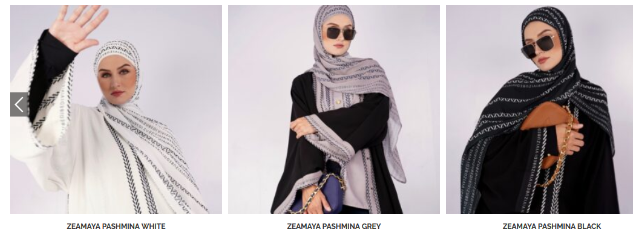
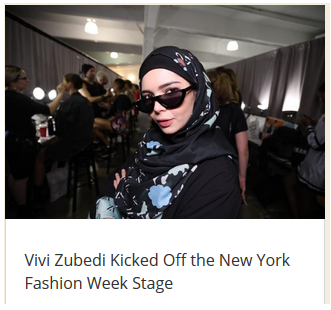
Apart from Vivi Zubedi, there are several other influencers who have a wider use of Instagram as a means of showcasing their modest fashion products and have attracted considerable number of not only in Dubai but also in the world over. The following table illustrates some of the top Instagram influencers that emerged from our analysis.
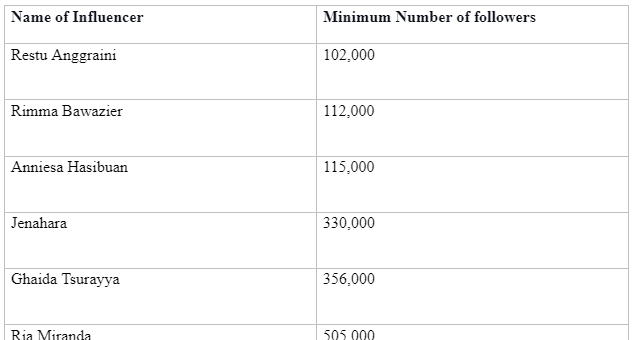

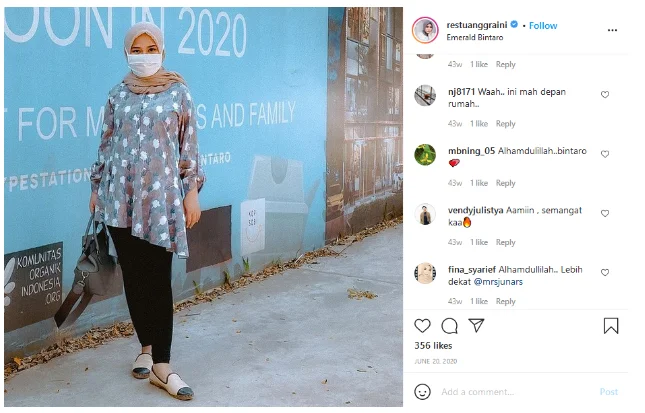
Restu Anggraini came into the limelight with her brand in 2011 with different labels for the mass market, majorly targeting international markets (Lewis & Tarlo, 2011). In the DNA of her brand is young, innovative and modern and this is how she promotes her Instagram brand too. Another designer, Jenahara, uses her Instagram to share information about her achievements in the fashion industry. For instance, in the Instagram photo below, Jenahara is seen posing for a photo during the 2016 London fashion week
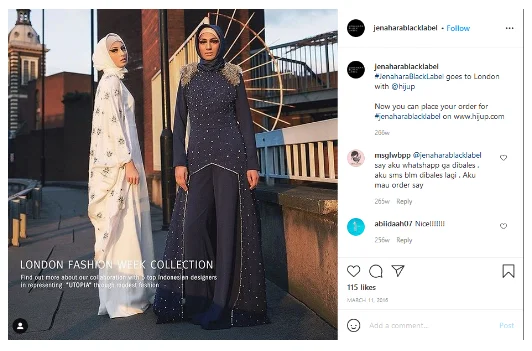
Another significant trend from the analysis is that some of the Hijabers who have a huge following in Instagram also have an active blogging career, whereby the link their Instagram pages to their blogs to drive traffic on both platforms. The following table illustrates some of Instagram’s most popular hijabers who also double up as great bloggers


Clearly, instangramers play a significant role in promoting the Hijab trend, and sometimes they create trends by promoting other designer trends. This adoption of Instagram as a digital platform for the discussion about modest dress gives other upcoming modest fashion influencers to express themselves and discuss about modest fashion. For instance, an analysis of the Instagram accounts of the influencer’s followers reveal a pack of other young Muslim women who look up to these influential women for inspiration. The following is a list of some of the younger aspiring women:
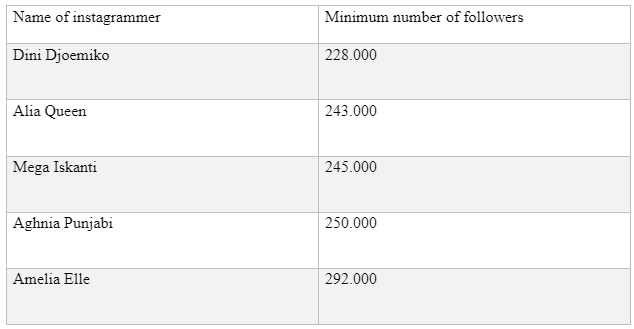
The use of Hashtags
The use of hashtags has also enabled an easier spread of modest fashion across various population demographics in Dubai. For instance, a review of Instagram content reveals that various forms of hastags are popularly used by hijabisters to spread the word of modest fashion and initiate conversations and debates about the fashion. For instance, a mere search of the #hijab on Instagram reveals a series of such hashtags that attract as high as 62 million posts globally. Below is a snapshot of the search:
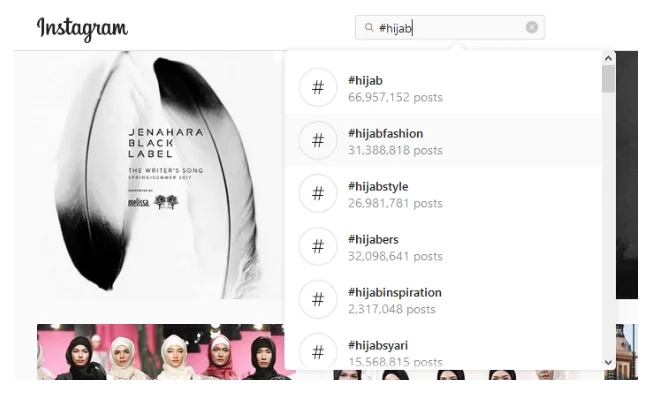
Similarly, an Instagram search of #modest revealed a series of hashtags with thousands of posts as illustrated below:
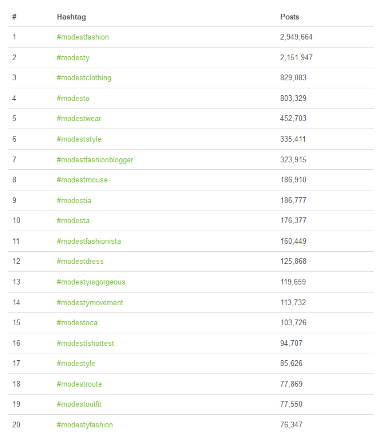
Ideally, Instagram hashtags are a combination of numbers, emojis, and letters preceded with the # symbol. They categorize content and make them more visible. For instance, anyone who clicks a hashtag or searches the hashtag will land on a page showing all the posts tagged with that hashtag. This implies that the greater number of posts on a hashtag, the greater number of people it reaches.
Therefore, the hashtags present as an important way of expanding an Instagram audience. For instance, anyone who uses a modest fashion hashtag will have their posts appear on that hashtag’s page. Similarly, if an influencer uses that hashtag on their Instagram Story, it can be included in another relevant hashtag Story, which also appears on the Instagram page. People can also choose to follow the hashtags, which means they can see an influencer’s hashtagged post in their feed even if they do not follow the influencer.
The following figure illustrates how Instagram facilitates the expansion of modest fashion movement:
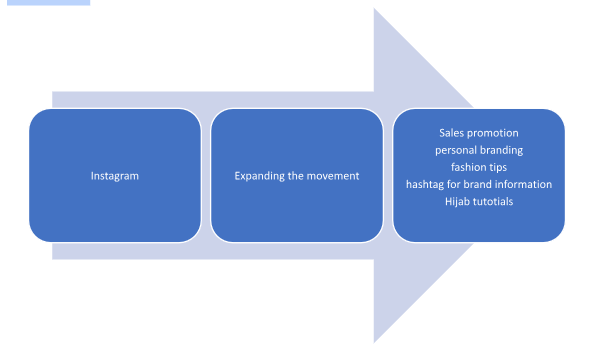
Discussion and Conclusion
This study set out to explore the role of social media (Instagram) in showcasing Muslim women’s womanhood and beauty through modesty fashion. By conducting a content analysis on the Instagram accounts of some of Dubai’s and indeed, the world’s most popular modest fashion models, this study discovered the that social Instagram plays a significant role as a platform for diverse representation of hijabis, whereby Muslim women view Instagram as a platform for determining and [presenting their unique accents or identities.
In the process of constructing these representations, the women continuously experiment their looks, revealing the fact that they are in the process of exploring and enjoying what it means to be a young Muslim woman in a modest outfit. This experimentation entails styling the different clothing e.g. the hijab in different ways and outfits that are significantly inspired by modern fashion trends.
Instagram has also emerged as a string platform for entrepreneurs in the modest fashion industry to promote their products. They post their style-fashion-dress concepts on Instagram and then influence customers to buy them. Based on the evidence from the content analysis, most of the customers follow the developments on Instagram to keep up with the latest fashion and new modest fashion trends; creating a sort of modest fashion movement on Instagram. Therefore, Instagram has emerged as a platform for Muslim women to not only showcase their Muslim womanhood through modest fashion, but also a platform where they self-present their identities; all through sales and promotion of modest fashion items, personal branding, gaining fashion information and tips, and accessing modest fashion reference materials and tutorials. These findings have a significant implication for practice among marketing professionals. First, it implies that social media, especially Instagram, is multisectoral and entails a variety of niche markets that marketers can explore to target different demographics with different products. Secondly, Modest fashion, just like regular fashion, has a big market with similar consumer or buyer behavior. therefore, marketers can use the same marketing concepts, tactics and strategies to market modest fashion products, so long as they are effective.
Limitations of the study
Despite its findings, there are several limitations that might affect the generalization of this study’s findings. For instance, all the Instagram modest fashion models whose Instagram content were analyzed were of younger age, yet the fashion industry is one that is characterized by intergenerational discrepancies. There is a need for further research on how older Muslim women use Instagram and whether they also subscribe to the social media modest fashion movements. Also, due to the continuous emergence of other social media platforms such as Twitter, Facebook, LinkedIn and You Tube as major marketing platforms, there is need to explore the concept modest fashion as it relates to these platforms, so that marketers can have a holistic understanding of social media marketing of modest fashion as opposed to only one social medial platform.
References
- Hennink, M., Hutter, I. and Bailey, A., 2020. Qualitative research methods. Sage.
- Castleberry, A. and Nolen, A., 2018. Thematic analysis of qualitative research data: Is it as easy as it sounds?. Currents in Pharmacy Teaching and Learning, 10(6), pp.807-815.
- Edwards, R. and Brannelly, T., 2017. Approaches to democratising qualitative research methods.
- Dougherty, D., 2017. Grounded theory research methods. The Blackwell companion to organizations, pp.849-866.
- Johnson, G.A. and Vindrola-Padros, C., 2017. Rapid qualitative research methods during complex health emergencies: a systematic review of the literature. Social Science & Medicine, 189, pp.63-75.
- Shaw, R.L., Bishop, F.L., Horwood, J., Chilcot, J. and Arden, M., 2019. Enhancing the quality and transparency of qualitative research methods in health psychology. British Journal of Health Psychology, 24(4), pp.739-745.
- Tracy, S.J., 2019. Qualitative research methods: Collecting evidence, crafting analysis, communicating impact. John Wiley & Sons.
- Scharp, K.M. and Sanders, M.L., 2019. What is a theme? Teaching thematic analysis in qualitative communication research methods. Communication Teacher, 33(2), pp.117-121.
Dig deeper into Impacts of covid-19 on housing sector with our selection of articles.
- 24/7 Customer Support
- 100% Customer Satisfaction
- No Privacy Violation
- Quick Services
- Subject Experts



